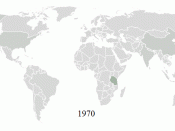At the national level, we focus on evaluating the effect of China's WTO accession
on macroeconomic indicators as well as on agricultural trade, including imports and
exports. As expected and similar to many other studies, China's WTO accession, by
reducing or eliminating import tariffs, would benefit the economy at the aggregate level.
The gain comes from a more efficient allocation of current factor endowments, which
allows GDP and the level of consumers' aggregate consumption to rise. While fully
liberalizing agricultural trade only (scenario 2) raises GDP by 0.23 percent, liberalizing
both agricultural and non-agricultural trade (scenario 3) allows the gain in GDP to almost
triple to 0.8 percent. The result is comparable with those from the other studies [e.g.,
China's GDP rises by one percent in USITC (1999) and 1.4 - 2 percent in Lejour (2000),
in which the long-run cumulative effect of tariff reduction is taken into account]. With
more imports of foreign goods at lower prices, the domestic price level declines.
However, the decline mainly happens in agricultural pric es when agricultural trade is
liberalized. Once both agricultural and nonagricultural trade are fully liberalized, the
decline in agricultural prices becomes much smaller and is comparable with the change in
nonagricultural prices and the consumer price index, as well as the depreciation of the
real exchange rate (Table 4). This comes from the higher demand for agricultural
products due to higher income level after full liberalization.
If only agricultural trade is liberalized, rural income declines in both nominal and
real terms due to the decline in agricultural income, including returns to labor employed
in agriculture as well as to land and agricultural capital. In contrast, urban income rises
in the same scenario. If both agricultural and non-agricultural trade are liberalized,
agricultural and rural incomes increase both in real and...



Good essay.
Quite informative and educational.I like this essay because it taught me many things that I was not previously aware of.
2 out of 2 people found this comment useful.